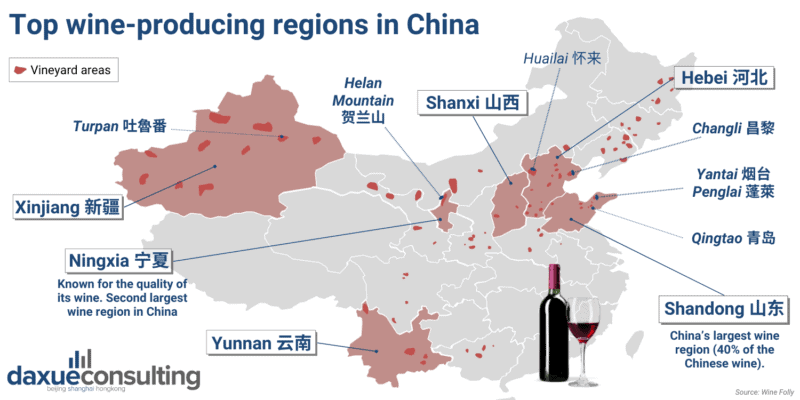Chinese people take breakfast very seriously: it’s a core aspect of people’s lifestyles. With so many different cultures across China’s provinces, breakfast is also representative of the local customs and traditions. This map explores China’s top ten iconic breakfast dishes in different provinces. The selected dishes are not only popular and delicious, but also have a rich cultural heritage.
Youtiao and soymilk (油条豆奶)
A classic breakfast from Beijing, youtiao (油条), literally translates as “oily stick”, is a wheat-based fried dough, paired with soymilk. This golden fried delicacy along with the subtle sweet beverage made from fresh soya beans creates a delicious combination of sweet and savory. Typically enjoyed in northern China, this iconic breakfast pairing is dated back to the story of Yue Fei during the Southern Song dynasty (1127–1279).
Shandong-style pancakes (山东煎饼)
Both a popular street food and breakfast, jianbing (煎饼), or fried pancake is made from simple ingredients like flour, corn, sorghum, and millet. People from Shandong usually enjoy their jianbing with scallions inside. Other ingredients like pork, eggs, and fried chili can also be added. Shandong-style pancakes can be traced back to the Ming Dynasty (1368-1644) in Tai’an, making this dish a quintessential Chinese food.
Hot dry noodles (热干面)
With endless options of noodle dishes in China, hot dry noodles from Wuhan, the capital of Hubei province, are considered the top ten most common and favoured noodle dishes. “Re” (热) means hot, “Gan” (干) means dry, and “Mian” (面) is noodles, consisting of only a few simple ingredients: sesame paste, garlic, and soy sauce. Optional toppings such as pickled vegetables and chili oil are usually served as well.
Glutinous rice rolls (粢饭团)
A classic Shanghainese breakfast, “Ci fan tuan” (粢饭团), is a glutinous rice ball typically filled with youtiao (fried dough), pork floss, and pickled vegetable. For those with a sweet tooth, cifantuan also comes with sugar and sesame as fillings. Fantuan or glutinous rice is a rice dish that originates in the Jiangnan area of eastern China.
Ningbo tangyuan (宁波汤圆)
A mochi-like glutinous rice ball, Tangyuan (汤圆) is believed to date back to the Tang dynasty (618-907 AD). This breakfast dish or dessert symbolises reunion as tangyuan also sounds like “tuanyuan” (团圆). Although this round delicate rice ball can be found everywhere in China today, the most renowned varieties come from Ningbo, and are usually stuffed with black sesame, sugar, and lard.
Dim sum (点心)
Originating from the Song Dynasty (960-1279), dim sum is one of the quintessential of Chinese cuisine today. Traditionally eaten in southern China’s Guangdong province, dim sum is a meal served in steamers and plates of dumplings, buns, rolls, meats, vegetables, rice, and desserts, and is typically paired with tea. As a popular Cantonese breakfast, some restaurants serve dim sum as early as five in the morning.
Changsha rice noodles (长沙米粉)
Being a major rice-producing region, rice noodles are a staple food for people from Hunan. Especially people in Changsha, who typically enjoys rice noodles for breakfast. Changsha-style rice noodles are generally served in pork bone soup, with shredded pork, green onion, chili, etc.
Hot and sour noodles (酸辣粉)
The name “Suan la fen” (酸辣粉) directly describes Chongqing’s famous noodle dish- an explosive combination of spicy, numbing, and sour flavours in its soup base. A classic dish from Chongqing and in Sichuanese cuisine, Suanlafen uses starchy sweet potato glass noodles which create a silky and slippery texture, served with toppings such as crushed soybeans or peanuts and scallions.
Lanzhou beef noodle soup (兰州牛肉面)
As one of the oldest beef noodle soups in China, Lanzhou beef noodle soup was originated from the Tang dynasty in northwest China. This dish stands out from the other endless noodle options in Chinese cuisine with its handpulled noodles and availability to cater to the Muslim diet, as the meat served is often halal and the dish contains no soy sauce.
Hot pepper soup (糊辣汤)
Another popular breakfast dish in northern China, “Hulatang” (糊辣汤), directly translates as hot pepper soup, was originally created in Henan province but is now a staple in the cuisine of Shaanxi province. Distinguished by its thick, sticky texture, and spicy and sour flavour, hulatang contains a variety of ingredients like beef, rice noodles, ginger, and vegetables.




